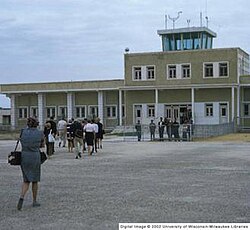Mazar-i-Sharif International Airport: Difference between revisions
No edit summary |
No edit summary |
||
| Line 1: | Line 1: | ||
{{Infobox airport |
{{Infobox airport |
||
| name = Maulana Jalaluddin Balkhi International Airport |
| name = Maulana Jalaluddin Balkhi International Airport |
||
| nativename = |
| nativename = |
||
| nativename = |
| nativename = |
||
| nativename-a = |
| nativename-a = |
||
| nativename-r = |
| nativename-r = |
||
| Line 39: | Line 39: | ||
}} |
}} |
||
'''Maulana Jalaluddin Balkhi International Airport''' |
'''Maulana Jalaluddin Balkhi International Airport''' ({{lang-ps|د مزاری شریف نړیوال هوایی ډګر}}; {{lang-fa|فرودگاه مولانا جلال الدین محمد بلخی}}; formerly known as '''Mazar-i-Sharif Airport''' {{Airport codes|MZR|OAMS}}, is located 9 km east of [[Mazar-i-Sharif]] in northern [[Afghanistan]], a journey of 15 minutes by taxi from the center of the city. The airport comes with a dual-runway capable of handling large aircraft such as [[Boeing 747]], [[Boeing C-17 Globemaster III]] and [[Antonov An-225 Mriya|Antonov An-225]]. It is Afghanistan's 4th largest after [[Herat International Airport]].<ref name=kfw/><ref>[http://www.manufacturersinturkey.net/2011/09/ahmet-aydeniz-construction-food-tourism.html images of Mazar-i-Sharif Airport]</ref> The airport has facilities for up to 1,000 passengers.<ref name="Balkh airport terminal inaugurated"/> |
||
Originally built by engineers from the [[Soviet Union]] in the 1950s, the airport serves the Afghan population north of the country. A new 60 million euro terminal was added to the airport in recent years while the older terminal is now used for domestic flights. |
Originally built by engineers from the [[Soviet Union]] in the 1950s, the airport serves the Afghan population north of the country. A new 60 million euro terminal was added to the airport in recent years while the older terminal is now used for domestic flights. |
||
Revision as of 23:38, 27 October 2013
Maulana Jalaluddin Balkhi International Airport | |||||||||||
|---|---|---|---|---|---|---|---|---|---|---|---|
 Mazar-i-Sharif Airport in 1969 | |||||||||||
| Summary | |||||||||||
| Airport type | Civilian/Military | ||||||||||
| Owner | |||||||||||
| Operator | Afghan Ministry of Transport and Civil Aviation / ISAF | ||||||||||
| Serves | Northern Afghanistan | ||||||||||
| Location | Mazar-i-Sharif | ||||||||||
| Elevation AMSL | 1,282 ft / 391 m | ||||||||||
| Coordinates | 36°42′24.8″N 67°12′32.7″E / 36.706889°N 67.209083°E | ||||||||||
 | |||||||||||
| Runways | |||||||||||
| |||||||||||
Source: Landings.com[1] | |||||||||||
Maulana Jalaluddin Balkhi International Airport (Pashto: د مزاری شریف نړیوال هوایی ډګر; Persian: فرودگاه مولانا جلال الدین محمد بلخی; formerly known as Mazar-i-Sharif Airport (IATA: MZR, ICAO: OAMS), is located 9 km east of Mazar-i-Sharif in northern Afghanistan, a journey of 15 minutes by taxi from the center of the city. The airport comes with a dual-runway capable of handling large aircraft such as Boeing 747, Boeing C-17 Globemaster III and Antonov An-225. It is Afghanistan's 4th largest after Herat International Airport.[2][3] The airport has facilities for up to 1,000 passengers.[4]
Originally built by engineers from the Soviet Union in the 1950s, the airport serves the Afghan population north of the country. A new 60 million euro terminal was added to the airport in recent years while the older terminal is now used for domestic flights.
History
Mazar-i-Sharif airport was built in the 1950s by assistance from the Soviet Union during the Cold War, when the Soviets and the Americans were trying to spread their influence in the Middle East and South Asia.[5] Between the 1960s and late 1970s, for the first time large number of tourists began arriving to see historical places in the city.
The airport was heavily used in the 1980s by the Soviet forces from which it launched daily flight missions to hit targets in the Mujahideen controlled territories of the southeast. It also served as one of the main hubs for deploying troops from the neighboring former Soviet Union.
NATO presence and expansion

Germany took command of the International Security Assistance Force (ISAF)'s Regional Area North at the end of March 2006. The airfield functions as a main hub for the exchange of personnel as well as air cargo for the international stabilization and peace support forces in northern Afghanistan. Since September 2007 a TACAN installation for an instrument landing system is available for bad weather operation.[6] Camp Marmal was built next to the airport in 2005, which has gradually expanded to one of the largest military bases in Afghanistan. It serves all ISAF personnel, including U.S. and Afghan Armed Forces.
Work on a new international terminal began in 2010 and was completed in 2013. A special inauguration ceremony was held in June 2013, which was attended by German Foreign Minister Guido Westerwelle, Afghanistan's Transport and Aviation Minister Daoud Ali Najafi, Balkh's Governor Atta Muhammad Nur and some parliamentarians. After the inauguration, the airport was named Maulana Jalaluddin Balkhi International Airport. The expansion of the airport was a joint venture of Germany and the United Arab Emirates (UAE), which cost 60 million euros and took about three years to complete.[4][2] The airport's new international terminal takes its name from Maulana Jalaluddin Balkhi, also known as Rumi.
Airlines and destinations
| Airlines | Destinations |
|---|---|
| Ariana Afghan Airlines | Kabul, Moscow [7] |
| Aseman Airlines | Mashad, Tehran-Imam Khomeini |
| Kam Air | Kabul, Mashad, Tehran-Imam Khomeini |
| Turkish Airlines | Istanbul-Atatürk (begins 20 November 2013) [8] |
See also
References
- ^ Airport record for Mazar-e-Sharif Airport at Landings.com. Retrieved 2013-8-1
- ^ a b Engine of Economic Upswing in the Region
- ^ images of Mazar-i-Sharif Airport
- ^ a b "Balkh airport terminal inaugurated". Pajhwok Afghan News. 9 June 2013. Retrieved 2013-06-09.
- ^ The forgotten country
- ^ Allied Joint Force Command Brunssum
- ^ Ariana schedule
- ^ "Turkish Airlines to Start Mazar-i-Sharif Service from late-Nov 2013". Routes Online / Routes. 23 September 2013. Archived from the original on 23 September 2013.

